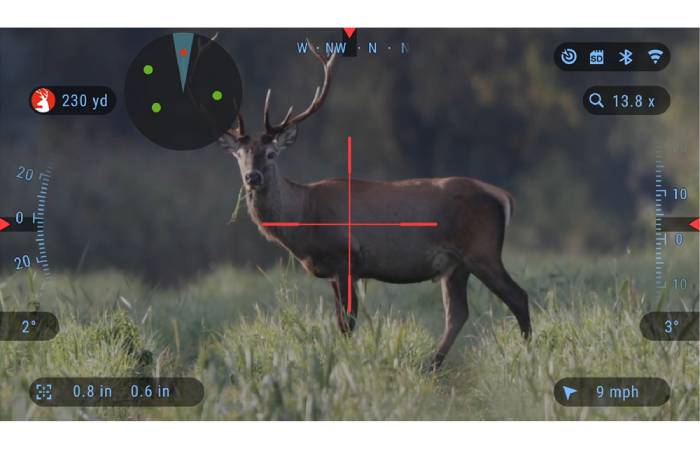Digital vs Traditional The Evolution of Smart Rifle Scopes

In an age where technology is continually enhancing all aspects of life, it’s no surprise that the world of firearms and shooting sports isn’t being left behind. Over the years, a new class of rifle scopes, often referred to as “smart scopes”, “e-scopes”, or “electro-optics”, has emerged, promising to revolutionize marksmanship. Utilizing advanced electronics and wireless technology, these scopes are designed to enhance a shooter’s ability to place bullets consistently in a tiny area over vast distances. These devices promise to transform the optic and firearms industry by integrating sophisticated technology into traditional rifle scope designs, offering a range of features that can improve accuracy, tracking, and overall shooting experience.
Understanding Smart Scopes
These cutting-edge scopes use technology to derive an aiming solution, typically represented as an illuminated dot on the crosshair or a digital display inside the scope. Some smart scopes integrate built-in laser rangefinders, while others use Bluetooth to receive ballistic information transmitted from a mobile-phone app. There are even scopes that wirelessly communicate with “smart” rangefinders.
A decade ago, the market witnessed the first of this species with the Burris’ rangefinding Eliminator and the TrackingPoint system developed by partners of Remington Arms. Despite initial criticism regarding ethical concerns due to its reliance on technology, the digital scope market has expanded rapidly. The evolution of integrated circuitry, microprocessing, and wireless technology has prompted more companies to produce smart scopes, with many brands planning to release their versions.
The Technology Inside
Smart rifle scopes employ several advanced technologies:
- Digital Display: The most noticeable feature is the digital display, which can provide a clear image of the target, often with zoom capabilities. This display can also overlay various data points and indicators, such as range, wind speed, and shot trajectory.
- Sensors: Smart scopes contain a variety of sensors that can measure factors like atmospheric conditions, incline, and cant, which can all affect the trajectory of a bullet.
- Ballistic Calculator: Perhaps the most vital component of a smart rifle scope is the ballistic calculator. This uses the data from the scope’s sensors, coupled with pre-loaded cartridge and firearm data, to calculate the bullet’s trajectory and advise the shooter on holdover and windage adjustments.
- GPS and Connectivity: Many smart scopes incorporate GPS, enabling them to tag the location of each shot. Furthermore, with Wi-Fi or Bluetooth connectivity, they can connect to a smartphone app, allowing for additional features like shot tracking, video recording, and more.
Smart Scopes vs. Traditional Scopes
While the goal of all riflescopes remains the same, the approach of traditional scopes compared to electronic scopes is as varied as taking a picture with a manual camera versus a digital one. Traditional scopes require users to apply reticle references or turret adjustments based on their accumulated knowledge of bullet drift and drop. In contrast, smart scopes, like digital cameras, arrive at a shooting solution based on electronic processors, battery-powered sensors, and computational software that quickly applies vectors and algorithms.
Smart Scopes Influence and Pros and Cons
The influence of both electro-optics and precision scopes on the sports-optics industry is undeniable. Gone are the days of relying solely on “Ke
ntucky windage” holdover. Advertising, social-media influencers, sponsored competitive shooters, and word-of-mouth testimonials have fostered an expectation that civilians using this new class of optics can legitimately make one-shot hits on small targets at distances up to, and often exceeding, 1,000 yards, and on big-game animals beyond 500 yards with little to no training.
Sales of electronic scopes are also rising as more shooters seek a scope that can maximize the performance of the new generation of hyper-accurate rifles on the market. Despite these intriguing capabilities the traditional rifle scope still holds the larger market share with smart scopes being more of a niche market.
However, the question remains:
Is this technology worth owning?
Are these sophisticated optics worth the time and patience required to download a mobile app, input precise ballistics data, and then trust the software to make a shot when a big buck is on the line?
Is the risk of a battery failure worth the upside, which is the ability to hit distant targets shot after shot without having to learn the language of mils or minutes of angle?
The biggest question of all is if these smart optics are killing the sports of long-range shooting and hunting. Is it considered cheating?
The Future of Smart Scopes
Electronics, which have pervaded so many other aspects of our lives, would naturally extend to our optics and on our rifles. As technology continues to evolve, the variety and sophistication of smart scopes will undoubtedly increase. And while some shooters may still prefer the tactile feel and reliability of traditional scopes, there’s no denying that smart scopes, with their advanced features and capabilities, represent a significant shift in the optics industry. As more of these smart scopes come to the market, often at competitive prices, the choice between traditional and digital becomes more nuanced, depending not just on the user’s comfort with technology, but also on their specific shooting requirements and environments.
Popular Smart Rifle Scopes
- Burris Eliminator 4-16x50mm: This scope pioneered the integration of laser rangefinding in its design. Known for its reliability, the Burris Eliminator features an in-built inclinometer that adjusts for any angle, providing accurate ballistic calculations on the fly. This scope is particularly useful for long-distance shooting.
- ATN X-Sight 4K Pro 5-20x: The ATN X-Sight incorporates 4K sensor technology for excellent resolution and sharp, vivid colors. The device has a smart mil-dot reticle, is capable of recording and streaming footage, and can be controlled via a mobile app. The ATN X-Sight is well-suited for both day and night shooting scenarios.
- Swarovski DS 5-25x52mm: The Swarovski DS stands out with its automated aiming point feature. It factors in distance, air pressure, temperature, and angle to provide an accurate illuminated dot for the shooter. This premium scope brings Swarovski’s famed optical performance to the smart scope world, providing a stunningly clear and bright image.
- Sig Sauer Sierra6BDX 5-25x56mm: This smart scope from Sig Sauer integrates with the BDX (Ballistic Data Xchange) system, allowing it to communicate with a paired rangefinder for ballistic calculations. It then displays holdover and windage information via illuminated points on the reticle. A high-performing scope, the Sierra6BDX is versatile, reliable, and packed with smart features.

Review Digital vs Traditional: The Evolution of Smart Rifle Scopes. Cancel reply